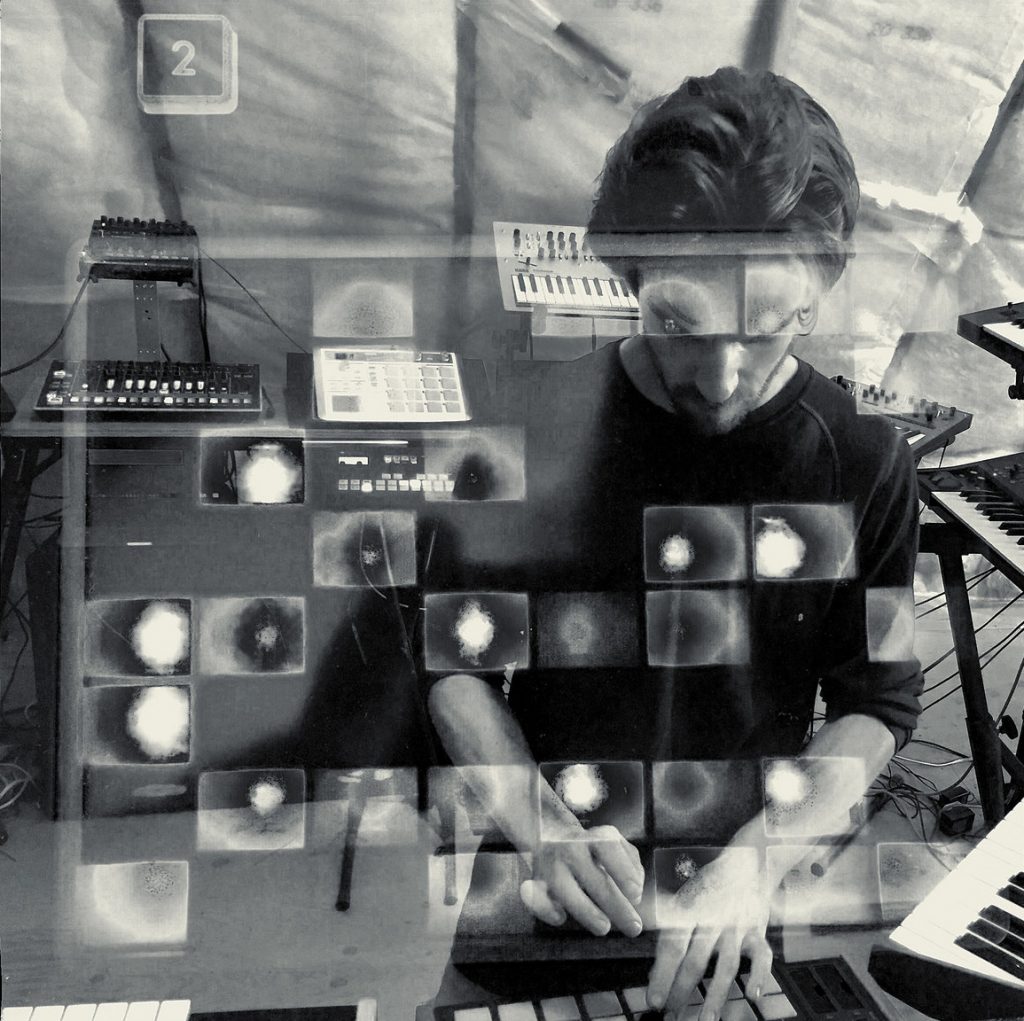Mr. Tuna is the Instagram handle of Truman Proudfoot, a maverick synth master out of Abbotsford, British Columbia. There, in a cavernous converted barn that serves as his studio, Mr. Tuna creates glorious improvised synthesizer music with an ever-rotating cast of collaborators.
His intuitive grasp of video and social media savvy has made Proudfoot an online star. Mr. Tuna shares secrets of his infectious approach to music-making, the joy of improv, and how he got his unique name. Plus, get an exclusive walkthrough of the artist’s drool-worthy Roland synth collection.
Unbridled Creativity
Tell us about the raw and unstructured way you like to create.
Well, the most important thing to me is just having something at my fingertips to play. Like if I’ve got to go digging around or looking for something, I’ve already lost the battle.
Improvisation is a key part of what you do. Is there any advice that you can give artists looking to free themselves from the restrictions of arrangement?
I would say music theory is important to know and experiment with, but you shouldn’t become tied to it. It’s about feeling what’s inside of you and letting your hands do the playing more than your mind. So much of what I do comes from muscle memory, or an ability to let myself forget what I’m trying to do and let what happens happen.
An Awe-Inspiring Collection
You are a true gearhead. When did you begin collecting synths?
It was a long time before I even had a concept of what a synthesizer was. I’d listen to music and get intrigued by the sound but had no idea what was happening. By circumstance, I stumbled across one. I loved the idea of a pure wave moving through the air and your ability to shape and sculpt and make it your own. It wasn’t the music part so much as the sound design aspects.
"I loved the idea of a pure wave moving through the air and your ability to shape and sculpt and make it your own."
Do you know how many total synthesizers you own?
It’s somewhere in the 16 range. I don’t know what counts and what doesn’t.
Then there’s the synth graveyard—the ones you’ve fixed a million times, but don’t work. You know that you don’t want to ever get rid of them. I have one mounted up against the door in my room. It’s one that’s dead now and I can’t use it anymore, but I could never get rid of because it was so special to me.
From Infuences to Influencer
Are there any particular artists or recordings that made an indelible mark on you as a young musician, who inspired you, got you interested?
My mom was very invested in music growing up. I remember her always remarking a particular bassline or some specific, deep aspect of this music I couldn’t appreciate or even consider as a kid. I was listening to something more as a whole than the parts.
Other than her taste and excitement, there was Beck’s album, Midnight Vultures. I remember listening to it the first time and thinking, that is weird—and I like it.
"I started with the idea that I was doing it for myself as something to reflect on and see how I'd grown as an artist.
Was there a moment when you were like, “Whoa, this is blowing up?” What did it feel like for you to see your community grow in that way?
Sharing music was more of a personal diary or a music journal. I started with the idea that I was doing it for myself as something to reflect on and see how I’d grown as an artist. My friends started encouraging me to share more seriously and put effort into making something of it.
Three or four years ago, I made a post with a Roland Boutique doing some random sequencing. It was nothing more than I’d been doing for three or four months beforehand, but this one started taking off. I remember telling my roommate it was at 95 views. That was it. It was just a snowball.
Strength in Collaboration
You seem to love collaborating with friends. It’s a big part of the way you talk about your music-making. What was it like working with TekaGrey?
Tyson is such a cool guy. We met when I went out to a local modular synth meetup. Tyson’s approach to making music is almost the polar opposite of mine in some respects. That’s what makes us such a cool team.
He’s detail-oriented and focused on nuances and tones, whereas I get lost in the bigger picture. I’m running back and forth, adding more, and getting lost in a sea of synths and sound. He’s sculpting and evolving this delay that he’s been working on or this loop he’s got running back and forth. It is neat how we tend to work in tandem or mesh together.
"My art is this studio—how it's all tied up in a knot or wired together to work as one beating heart."
What initiated our interview is that a lot of artists are building and creating from home right now. We wanted to make sure everyone feels connected while they play at home. Your studio is gorgeous.
Thank you. I’m prouder of the studio and how it’s put together than I am of even the videos or the music that I make with it. My art is this studio—how it’s all tied up in a knot or wired together to work as one beating heart.
A Garden of Roland
Walk us through some of your Roland gear.
We’ve got quite a wall of Roland here. First, we have the Jupiter-80. It’s the best playing keyboards that I’ve ever used. Then, I’ve got the original TR-808 here. I never, ever thought I would have the opportunity to own one. I’ve had this thing for about two years now and the novelty hasn’t worn off.
We’ve got the MC-707, the TR-8, and the TB-03, which does the 303-thing. I’ve got eight different drumkits set up on MC-707 and I can cycle through them. The 808 is like the best sounding thing I’ve ever heard in my life, but the TR-8 is so good I could never get rid of it.
I’ve got a stack of MX-1s. The MX-1 plays and mixes and turns everything into a glitch-fried knot. The MX-1 at the bottom is dedicated as a sub-mixer for the TR-808 because the 808 has individual outs.

Continuing our journey, we have the SYSTEM-8, which does the JUPITER, JUNO-106, classic vintage-synthesizer recreation bit, but differently. And we’ve got the JX-8P which I’m never selling. It is the most amazing-sounding synthesizer. The “Soundtrack” patch is so beautiful. Then, the SH-101 gets the whole mono, analog, screamy, squelchy acid sound. I love it, love it, love it.
Finally, if you took everything we looked at and tied them up, you’d have the JUPITER-X. I have never been more honored to have something in my presence. It’s everything they made it out to be and more. It has the wildest sounds and the build quality is eleven out of ten. The only synth I have that rivals its built quality is the Jupiter-80 which is like a big metal tank.
Finally, you have to tell us about your unique name. How did you become Mr. Tuna?
Well, I prepared something for this. I’m going to write out Mr. Tuna, and then I’m going to write up my name.
Can you see that? It’s an anagram.







